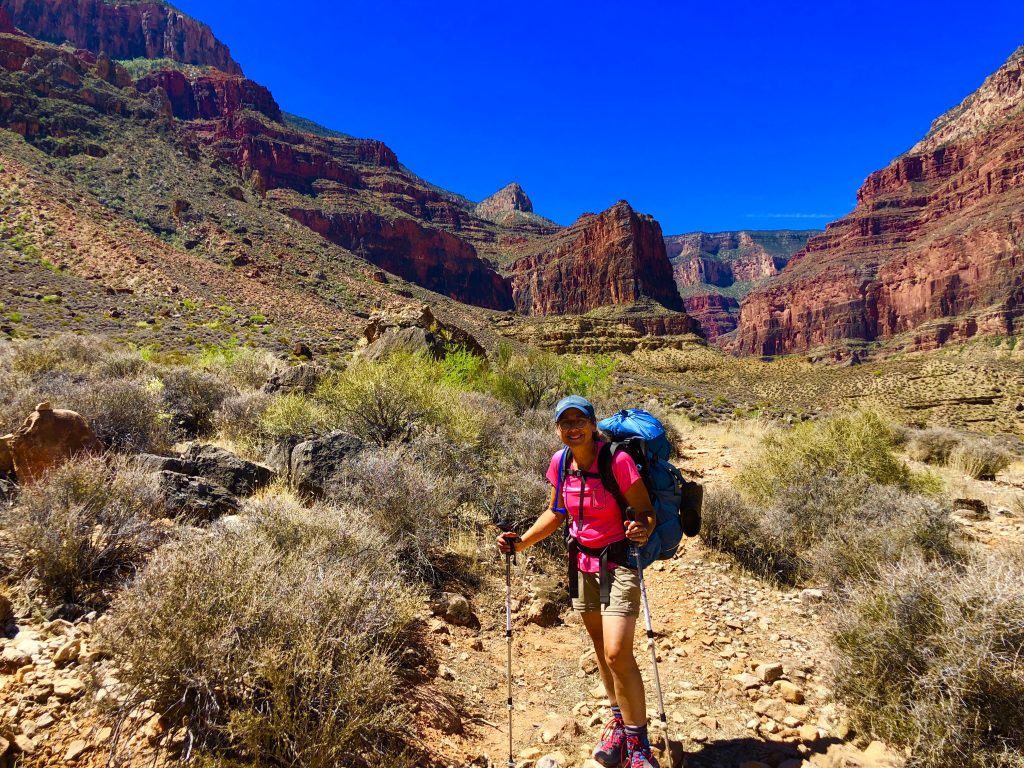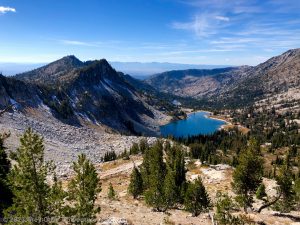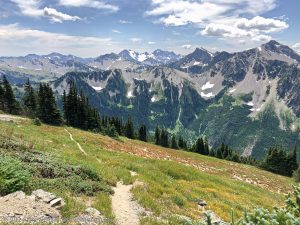
People hike to enjoy the outdoors and to take a break from the grind of daily life. A little backpacking etiquette makes everyone’s experience better.

Chris & Mac
We outventure to help you outventure!
Support Grey Otter Outventures!
Please help us continue to bring you great content:
I know, backpacking etiquette – really?
Yes! People are out on the trails to enjoy nature, the outdoors, and to take a break from the grind of daily life. Rude hikers ruin that mental space. Just remember, we are not alone out on the trails and our fun should not ruin the fun of others. To that end, the backpacking community developed some simple etiquette rules everyone can follow to ensure we all enjoy our individual experiences:
-
Uphill Hikers Have Right of Way
Downhill hikers should always yield to uphill hikers. There is a good reason for this – unlike downhill hikers, it takes a good deal of effort for an uphill hiker, particularly in steep terrain, to get moving again and regain their stride. So, if you are going downhill and encounter uphill hikers, be polite, step aside, smile, and say ‘hi’. You will enjoy the same courtesy when you are going uphill.
-
Be Mindful of Horses and Mountain Bikers
All trail users should yield for horses. They can be skittish and we can all help riders by moving aside and yielding the trail
As a general rule, mountain bikers should yield to hikers. As a practical matter, however, it may be hard for a mountain biker going downhill to stop or for one going uphill on a steep climb to get started again. If possible, yield the trail to fast moving or climbing mountain bikers – they will appreciate your courtesy and this continues to build good will in the outdoor community.
-
Groups Should Hike Single File When Encountering Other Hikers
There is perhaps nothing quite as annoying as being on a peaceful hike ang looking up to see a crowd of hikers in a pack filling the trail. Unfortunately, when in groups people sometimes forget that they do not own the trail. As it stands now, trail use is becoming more and more restrictive due to growing numbers of users – resulting in mandatory permits, trail quotas, and group size limitations. Unruly and rude groups make the call for restrictions grow even louder. It benefits everyone if group leaders control their groups and ensure they follow etiquette such as hiking single file, as well as minimizing noise.
-
Keep Noise on the Trail to a Minimum
Again, people are on the trail to enjoy nature, the outdoors, and to take a break from the grind of daily life. They are not there to listen to your loud conversations, raucous laughter, and/or music. Your noise ruins their wilderness experience. Always keep in mind why everyone is on the trail and be courteous. If you want the rest, save it for the bar afterwards.
-
Stay On the Trail
Trails are sensitive and often so, too, is the terrain the trail crosses. Cutting trails (e.g., cutting from a higher switchback leg to a lower by going off trail) causes erosion that damages not only the terrain, but the trail. Going off trail also damages sensitive foliage, particularly in areas with short growing seasons. Help make sure these areas can be enjoyed by future generations by staying on the trail.
-
Step Aside to Take Breaks
When taking a break, step to the side of the trail. Remember, the trails are shared and other hikers should not have to step around those taking a break in the middle of the trail. This is a particular problem with groups, again underscoring the responsibility of group leaders to control their groups.
-
Don’t Feed Wildlife
Not only can feeding wildlife be dangerous for the hiker, it is dangerous for the animals. Remember, they don’t eat human food and some of our foods can hurt them. Additionally, animals can lose their fear of humans and come to see them as a source of food, resulting in injuries to hikers or annoyances when animals seek food. Finally, animals can become dependent on humans for food, resulting in starvation after the hiking season ends.
-
Be Respectful of the Environment When Choosing Your Campsite
The rules for backcountry camping are designed to protect the environment and ensure ongoing enjoyment for all. When use of designated campsites in the backcountry is required, follow the rule. If you are disperse camping (camping in informal areas where there are not designated sites), do your best to camp in areas where there are clear signs that others have camped there before. This reduces impact.
-
Campfires
Wildfires are a real problem. If campfires are not allowed, it is for good reason so comply. If campfires are allowed, limit your wood gathering to that which is already on the ground and make sure you properly extinguish your fire (see our article on campfire safety).
-
Food Storage
Food storage is a real concern. It is not only important because of bears (see our article on being “bear aware”) and large wildlife, it is important because of rodents. Coming nose to nose with a hungry bear aside, having your food taken or destroyed by wildlife is the quickest way to tank your backpacking trip. Poor food storage also attracts wildlife looking for food in the future and affects other backpackers, so we must all follow proper food storage principles (see our article on proper food storage).
-
Carry Out Your Garbage and Bury Your Waste
Plan to carry out any garbage and left-over food. Garbage is obvious, but food may not be. People food can hurt wildlife, so do not discard scraps.
Regarding your waste (i.e., poop), don’t just leave it on the ground. Dig what is called a “cat hole” of 6-8 inches in depth and at least 200 feet from water, deposit your waste and bury it. (Note: Some high traffic areas require packing out your waste. Make sure you know the rules for what you hike.)
-
Know the Rules and Guidelines of the Trails You Hike and Follow Them
Remember, even if a trail is on public lands, it is still governed by rules. Those who break the rules ruin it for others by causing further restrictions. If dogs are not allowed, don’t bring them. If a permit is required, get one. If bear spray is recommended, do yourself a favor and carry it. If dogs are required to be on a leash, keep them on one. If an area is marked as a restoration area, stay out. Following the rules helps the entire community.
Conclusion
So, these are the rules of backpacker etiquette. Pretty simple, right? If we just remember that we share the trails with others who also share our interest in the outdoors, following the rules of backpacker etiquette is a breeze. Happy hiking!
Gear We Use for Backpacking
To see descriptions of the gear Chris & Mac use for backpacking, as well as links to manufacturers and retailers offering the gear for sale, please CLICK HERE.
SAFETY DISCLAIMER: The activities discussed in this website are outdoor activities and, as such, have inherent risks to which participants are exposed. It is not the intent of this website, nor is it possible due to the variability of weather, terrain, equipment, and experience, to detail all of those risks. The information contained in this site is informational, but not instructive nor exhaustive. It is the sole responsibility of the user to ensure he/she is in good health, fully prepared, and fully informed as to dangers before undertaking any of the activities discussed in this website and the user does so at his/her own risk. The user understands that by using this website he/she acknowledges and accepts all risks associated with use of information from this website and participation in any particular activity addressed herein. Please see “Terms of Use” for additional information.
Want to share this article with your friends? Click on the share button below:
Want more?
Get the latest outventure updates by following us on social media . . .


